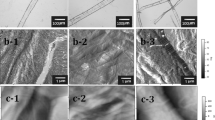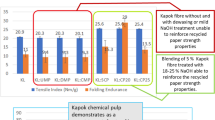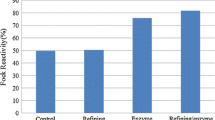Abstract
This work investigated the effect of using Kenaf bast fibre kraft pulps compared to Scotch Pine kraft pulps for producing microfibrillated cellulose (MFC) and its employment for improving mechanical and physical properties of handsheets made from unbleached kraft hardwood pulp. It was shown that MFC based on Kenaf fibres can be produced at higher consistencies [>5 % (w/w)] compared to when Scotch Pine is employed [≈2 % (w/w)] as raw material. The possibility of using a higher consistency when processing Kenaf is beneficial for the processing in microfluidizers. The rheological properties of the products were shown to be consistent with what is known for MFC-based systems. The studies indicate that the mechanical properties of handsheets from unbleached kraft hardwood pulp can be improved by replacing part of the unbleached kraft hardwood pulp fibres with either unbleached kraft Kenaf pulp or unbleached Scotch Pine kraft pulp. However, the same levels of improvements were obtained when using only a small amount [≈6 % (w/w)] of MFC based on Kenaf or Scotch Pine, when introduced into the system either as a dry strength additive or by coating pre-made handsheets. Finally, it was shown that the incorporation of MFC in handsheets decreases the air-permeability; this effect became amplified when the MFC was applied as a coating onto the handsheets.



Similar content being viewed by others
References
Afra E, Yousefi H, Hadilam MM, Nishino T (2013) Comparative effect of mechanical beating and nanofibrillation of cellulose on paper properties made from bagasse and softwood pulps. Carbohydr Polym 97:725–730
Agoda-Tandjawa G, Durand S, Berot S, Blassel C, Gaillard C, Garnier C, Doublier J-L (2010) Rheological characterization of microfibrillated cellulose suspensions after freezing. Carbohydr Polym 80:677–686
Ahola S, Österberg M, Laine J (2008) Cellulose nanofibrils—adsorption with poly (amideamine) epichlorohydrin studied by QCM-D and application as a paper strength additive. Cellulose 15(2):303–314
Aulin C, Gällstedt M, Lindström T (2010) Oxygen and oil barrier properties of microfibrillated cellulose films and coatings. Cellulose 17:559–574
Bahtoee A, Zargari K, Baniani E (2012) An investigation on fibre production of different Kenaf (Hibiscus cannabinus L.) genotypes. World Appl Sci J 16(1):63–66
Bhattacharya D, Germinario LT, Winter WT (2008) Isolation, preparation and characterization of cellulose microfibers obtained from bagasse. Carbohydr Polym 73:371–377
Dufresne A, Dupeyre D, Vignon MR (2000) Cellulose microfibrils from potato tuber cells: processing and characterization of starch-cellulose microfibril composites. J Appl Polym Sci 76(14):2080–2092
Eriksen Ø, Gregersen WØ, Syverud K (2008) The effect of MFC on handsheet surface and printing properties. In: Proceedings, progress in paper physics seminar, June 2–5, Espoo, Finland, pp 167–170
Faruq G, Alamgir MA, Rahman MM, Subha B, Motior MR (2011) Evaluation of genetic variability of Kenaf (Hibiscus cannabinus L.) from different geographic origins using morpho-agronomic traits and multivariate analysis. AJCS 5(13):1882–1890
Hassan EA, Hassan ML, Oksman K (2011) Improving bagasse pulp paper sheet properties with microfibrillated cellulose isolated from xylanase-treated bagasse. Wood Fiber Sci 43(1):76–82
Henriksson M, Henriksson G, Berglund LA, Lindström T (2007) An environmentally friendly method for enzyme-assisted preparation of microfibrillated cellulose (MFC) nanofibres. Eur Polymer J 43:3434–3441
Herrick FW, Casebier RL, Hamilton JK, Sandberg KR (1983) Microfibrillated cellulose: morphology and accessibility. J Appl Polym Sci Appl Polym Symp 37:797–813
Iotti M, Gregersen ØW, Moe S, Lenes M (2011) Rheological studies of microfibrillar cellulose water dispersions. J Polym Environ 19:137–145
Iwamoto S, Abe K, Yano H (2008) The effect of hemicelluloses on wood pulp nanofibrillation and nanofiber network characteristics. Biomacromolecules 9(3):1022–1026
Johansson C, Bras J, Mondragon I, Nechita P, Plackett D, Šimon P, Svetec DG, Virtanen S, Baschetti MG, Breen C, Clegg F, Aucejo S (2012) Renewable fibres and bio-based materials for packaging applications–a review of recent developments. BioResources 7(2):2506–2552
Jonoobi M, Harun J, Shakeri A, Misra M, Oksman K (2009) Chemical composition, crystallinity, and thermal degradation of bleached and unbleached Kenaf bast (Hibiscus cannabinus) pulp and nanofibres. BioResources 4(2):626–639
Jonoobi M, Harun J, Mathew AP, Hussein MZB, Oksman K (2010a) Preparation of cellulose nanofibres with hydrophobic surface characteristics. Cellulose 17:299–307
Jonoobi M, Harun J, Tahir PM, Zaini LH, Azry SS, Makinejad MD (2010b) Characteristics of nanofibres extracted from Kenaf core. BioResources 5(4):2556–2566
Jonoobi M, Harun J, Tahir PM, Shakeri A, Saiful Azry S, Davoodi Makinejad M (2011) Physicochemical characterization of pulp and nanofibres from Kenaf stem. Mater Lett 65:1098–1100
Kargarzadeh H, Ahmad I, Abdullah I, Dufresne A, Zainudin SY, Sheltami RM (2012) Effects of hydrolysis conditions on the morphology, crystallinity, and thermal stability of cellulose nanocrystals extracted from Kenaf bast fibres. Cellulose 19:855–866
Klemm D, Kramer F, Moritz S, Lindström T, Ankerfors M, Gray D, Dorri A (2011) Nanocelluloses: a new family of nature-based materials. Angew Chem Int Ed 50:5438–5546
Lindström T, Winter L (1988) Mikrofibrillärcellulosa som komponent vid papperstillverkning. STFI-meddelande C159
Manninen M, Kajanto I, Happonen J, Paltakari J (2011) The effect of microfibrillated cellulose addition on drying shrinkage and dimensional stability of wood-free paper. Nord Pulp Pap Res J 26(3):297–305
Missoum K, Martoïa F, Belgacem MN, Bras J (2013) Effect of chemically modified nanofibrillated cellulose addition on the properties of fiber-based materials. Ind Crops Prod 48:98–105
Mossello AA, Harun J, Tahir PM, Resalati H, Ibrahim R, Fallah Shamsi SR, Mohmamed AZ (2010) A review of literatures related of using Kenaf for pulp production (beating, fractionation, and recycled fibre). Mod Appl Sci 4(9):21–29
Orhan M (2010) Polylactide foams reinforced with wood fibres or microfibrillated cellulose. Uppsala University, Faculty of Science and Technology. Master Thesis, p 8
Pääkkö M, Ankerfors M, Kosonen H, Nykänen A, Ahola S, Österberg M, Ruokolainen J, Laine J, Larsson PT, Ikkala O, Lindström T (2007) Enzymatic hydrolysis combined with mechanical shearing and high-pressure homogenization for nanoscale cellulose fibrils and strong gels. Biomacromolecules 8:1934–1941
Ramakrishna S, Fujihara K, Teo WE, Yong T, Ma Z, Ramaseshan R (2006) Electrospun nanofibres: solving global issues. Mater Today 9(3):40–50
Rezayati Charani P (2013) Production and using of Kenaf nanofibers for improvement of kraft paper properties. Gorgan University of agricultural sciences and natural resources. Doctoral Thesis, p 63
Rezayati Charani P, Dehghani-Firouzabadi M, Afra E, Shakeri A (2013) Rheological characterization of high concentrated MFC gel from Kenaf unbleached pulp. Cellulose 20(2):727–740
Saarikoski E, Saarinen T, Salmela J, Seppälä J (2012) Flocculated flow of microfibrillated cellulose water suspensions: an imaging approach for characterization of rheological behaviour. Cellulose 19(3):647–659
Saarinen T, Lille M, Seppälä J (2009) Technical aspects on rheological characterization of microfibrillar cellulose water suspensions. Ann Trans Nord Rheol Soc 17:121–128
Saito T, Nishiyama Y, Putaux J, Vignon M, Isogai A (2006) Homogeneous suspensions of individualized microfibrils from TEMPO-catalyzed oxidation of native cellulose. Biomacromolecules 7:1687–1691
Sarwar Jahan M, Saeed A, Ni Y (2012) Extraction of cellulose microfibrils from non-wood lignocellulose material using biorefinery concept. Lignocellulose 1(3):185–195
Sehaqui H, Liu A, Zhou Q, Berglund LA (2010) Fast preparation procedure for large, flat cellulose and cellulose/inorganic nanopaper structures. Biomacromolecules 11(9):2195–2198
Shakhes J, Zeinaly F, Marandi MAB, Saghafi T (2012) Effects of harvest time and cultivar on yield and physical properties fibres of Kenaf (Hibiscus cannabinus L.). Afr J Biochem Res 6(6):69–74
Siró I, Plackett D (2010) Microfibrillated cellulose and new nanocomposite materials: a review. Cellulose 17:459–494
Sjöström E (1993) Wood chemistry: fundamentals and applications. Gulf Professional Publishing. Hemistry: fundamentals and applications. Gulf Professional Publishing. p 133
Spence KL, Venditti RA, Habibi Y, Rojas OJ, Pawlak JJ (2010a) Aspects of raw materials and processing conditions on the production and utilization of microfibrillated cellulose. International Conference on Nanotechnology for the Forest Products Industry, Otaniemi
Spence KL, Venditti RA, Rojas OJ, Habibi Y, Pawlak JJ (2010b) The effect of chemical composition on microfibrillar cellulose films from wood pulps: water interactions and physical properties for packaging applications. Cellulose 17:835–848
Spence KL, Venditti RA, Habibi Y, Rojas OJ, Pawlak JJ (2010c) The effect of chemical composition on microfibrillar cellulose films from wood pulps: mechanical processing and physical properties. Bioresour Technol 101:5961–5968
Spence KL, Rojas OJ, Pawlak JJ, Venditti RA, Habibi Y (2011) A comparative study of energy consumption and physical properties of microfibrillated cellulose produced by different processing methods. Cellulose 18:1097–1111
Surip SN, Wan Jaafar WNR, Azmi NN, Anwar UMK (2012) Microscopy observation on nanocellulose from Kenaf fibre. Adv Mat Res 488–489:72–75
Syverud K, Stenius P (2009) Strength and barrier properties of MFC films. Cellulose 16:75–85
Taipale T, Österberg M, Nykänen A, Ruokolainen J, Laine J (2010) Effect of microfibrillated cellulose and fines on the drainage of Kraft pulp suspension and paper strength. Cellulose 17:1005–1020
Tanaka H, Ödberg L, Wågberg L, Lindström T (1990) Adsorption of cationic polyacrylamides onto monodisperse polystyrene latices and cellulose fiber: effect of molecular weight and charge density of cationic polyacrylamides. J Colloid Interface Sci 134(1):219–228
Turbak AF, Snyder FW, Sandberg KR (1983) Microfibrillated cellulose, a new cellulose product: properties, uses, and commercial potential. J Appl Polym Sci Appl Polym Symp 37:815–827
Villar JC, Revilla E, Gómez N, Carbajo JM, Simón JL (2009) Improving the use of Kenaf for kraft pulping by using mixtures of bast and core fibres. Ind Crops Prod 29:301–307
Wågberg L, Winter L, Ödberg L, Lindström T (1987) On the charge stoichiometry upon adsorption of a cationic polyelectrolyte on cellulosic materials. Colloids Surf 27:163–173
Zhang J, Song H, Lin L, Zhuang J, Pang C, Liu S (2012) Microfibrillated cellulose from bamboo pulp and its properties. Biomass Bioenergy 39:78–83
Author information
Authors and Affiliations
Corresponding author
Rights and permissions
About this article
Cite this article
Rezayati Charani, P., Dehghani-Firouzabadi, M., Afra, E. et al. Production of microfibrillated cellulose from unbleached kraft pulp of Kenaf and Scotch Pine and its effect on the properties of hardwood kraft: microfibrillated cellulose paper. Cellulose 20, 2559–2567 (2013). https://doi.org/10.1007/s10570-013-9998-z
Received:
Accepted:
Published:
Issue Date:
DOI: https://doi.org/10.1007/s10570-013-9998-z




